Persona 3 and Persona 4 broke all the rules. Games in the Shin Megami Tensei universe are supposed to have massive dungeons full of puzzles and traps, not a randomly generated crawl. They’re supposed to feature conversations with demons as an alternative to combat and as a method of recruitment, not a bunch of mini-games with cards dancing around the screen. For all their popularity, Persona 3 and Persona 4 are drastically different from their predecessors, so as a longtime fan it’s good to see Shin Megami Tensei: Devil Summoner: Soul Hackers provide a confident return to tradition.
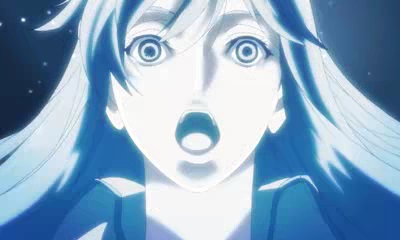 Soul Hackers Is Finally Here
Soul Hackers Is Finally Here
The traditional feel of the game is not surprising considering that Soul Hackers was originally released in Japan (as Devil Summoner: Soul Hackers) for the Sega Saturn in 1997. It is actually the sequel to the original Devil Summoner that was released in Japan in 1995 and which still has not received an official English translation. The 3rd game in the series, Shin Megami Tensei: Devil Summoner: Raidou Kuzunoha vs. The Soulless Army, is famous for its absurdly long title and, along with its sequel, Shin Megami Tensei: Devil Summoner 2: Raidou Kuzunoha vs. King Abaddon, were the only games in the Devil Summoner series to be released outside of Japan until now.
This 3DS version of Soul Hackers provides the first official English localization of the game and includes several improvements over the original. According to Atlus, the graphics were optimized for the 3DS and load times were improved. As promised, the game is very snappy. Battles pop up in a flash and there is almost no load time to speak of short of the few seconds it takes to load the game from the title screen.
Visuals From The Past
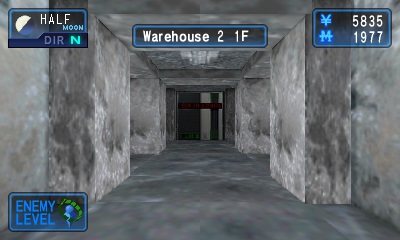 As for the visuals, the backgrounds and character portraits are detailed and look great on the handheld. Less impressive are the smaller character models that occasionally appear during story scenes and the low resolution movies that play from time to time. Aside from the awesome pre-game intro anime, the way the movies play is peculiar; the high resolution backgrounds get cropped down to a fraction of their normal size and then transition into the movies which use only a fraction of the available screen space. Unfortunately, they simply don’t impress the way they might have in the 90s when full motion videos were all the rage.
As for the visuals, the backgrounds and character portraits are detailed and look great on the handheld. Less impressive are the smaller character models that occasionally appear during story scenes and the low resolution movies that play from time to time. Aside from the awesome pre-game intro anime, the way the movies play is peculiar; the high resolution backgrounds get cropped down to a fraction of their normal size and then transition into the movies which use only a fraction of the available screen space. Unfortunately, they simply don’t impress the way they might have in the 90s when full motion videos were all the rage.
While exploring the various buildings and dungeons, Soul Hackers employs the familiar first person perspective used in all of the early Shin Megami Tensei games. While moving around one step at a time, the Automap fills out on the bottom screen (or is completely revealed if an optional Automap Hack is enabled). On the top screen, the first person view is displayed. For the most part, the visuals here are simplistic. There is rarely anything of incredible visual significance in this aspect of the game. The same tiles repeat over and over again, and the Automap provides much more useful information to the player. The best part of the first person view is the depth perception made possible by the technology of the 3DS. That adds a great deal to the immersion of first person environments. It’s just a shame there isn’t a bit more to look at.
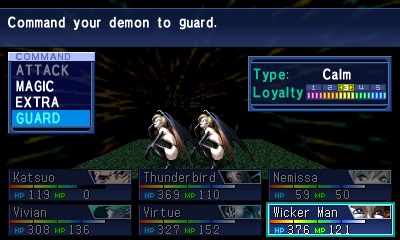 The visuals during combat also leave something to be desired. Shin Megami Tensei: Devil Summoner: Soul Hackers has new animations that were not included in the original, but these are mainly in the form of spell and ability animations. The sprites representing the demons themselves look fine, but they rarely move at all, aside from flying enemies swaying back and forth or a slight zoom effect that indicates which demon is attacking. The player’s characters are nowhere to be seen, as the game provides a first person view of the demons. Also, the backgrounds during battle are basically psychedelic animations. They do add some much needed movement to the battle scenes, but they don’t provide any further detail into the environments the player is exploring.
The visuals during combat also leave something to be desired. Shin Megami Tensei: Devil Summoner: Soul Hackers has new animations that were not included in the original, but these are mainly in the form of spell and ability animations. The sprites representing the demons themselves look fine, but they rarely move at all, aside from flying enemies swaying back and forth or a slight zoom effect that indicates which demon is attacking. The player’s characters are nowhere to be seen, as the game provides a first person view of the demons. Also, the backgrounds during battle are basically psychedelic animations. They do add some much needed movement to the battle scenes, but they don’t provide any further detail into the environments the player is exploring.
Though the overall look of combat is dated, given the source material, this is not surprising. When looked at as a game from 1997, the dated visuals can be forgiven. The demons are all interesting to look at, and when the action does get going, the spell and ability animations look pretty cool and get the job done.
The New Nemechi Program
Another new addition to Soul Hackers is the Nemechi Program which takes advantage of the 3DS StreetPass feature. Nemechi provides the player with a list of demons that can be recruited using 100, 150 or 300 D-Souls. The player can collect D-Souls by trading Play Coins or through StreetPass (one Play Coin is worth 15 D-Souls). All of the demons available on the list are a bit different from the demons that can be collected normally. They might come with extra abilities or higher stats than normal. Nemechi can grow through various stages using D-Souls and each stage unlocks more demons that can be purchased. It’s not a major game changer, but it is still a welcome addition to the game and a good enough reason to take your 3DS on the road. Assuming you have a bunch of Play Coins saved up from using the 3DS pedometer, you won’t need to StreetPass, but the option is there if you want to take advantage of it.
Great Voices Tell the Tale
By far the most significant of the new features in the 3DS version of Soul Hackers is voice acting. Not only are all of the main characters voiced, but a surprising number of less significant characters are also brought to life through a cast of voice talent that is entertaining to say the least. While I normally find the voice acting in JRPGs to be stiff or unnecessary, the voices in Soul Hackers add a lot of personality to the game. It is still a game where the story is told primarily through text boxes and occasional movies, but in this case, the addition of voices is a welcome change that helps tell the story.
 It’s just unfortunate that there isn’t more of a story to tell. Although the game takes 30-40 hours to complete, the great majority of that time is spent crawling through dungeons, with only sparse moments of dialogue to break up the grind (aside from the very lengthy intro to the game). It’s not unusual to spend a couple hours in a dungeon and then experience only 5 or 10 minutes or storyline before being sent to the next multi-hour dungeon. Pacing is a major issue in Soul Hackers, and it gets worse towards the end of the game when the dungeons are absolutely huge. Having enjoyed other Shin Megami Tensei games like Digital Devil Saga 1 & 2 and Nocturne, I was prepared for the often overwhelming dungeons, but for players who are used to Persona 3 and Persona 4, the pacing in Soul Hackers could be a major issue.
It’s just unfortunate that there isn’t more of a story to tell. Although the game takes 30-40 hours to complete, the great majority of that time is spent crawling through dungeons, with only sparse moments of dialogue to break up the grind (aside from the very lengthy intro to the game). It’s not unusual to spend a couple hours in a dungeon and then experience only 5 or 10 minutes or storyline before being sent to the next multi-hour dungeon. Pacing is a major issue in Soul Hackers, and it gets worse towards the end of the game when the dungeons are absolutely huge. Having enjoyed other Shin Megami Tensei games like Digital Devil Saga 1 & 2 and Nocturne, I was prepared for the often overwhelming dungeons, but for players who are used to Persona 3 and Persona 4, the pacing in Soul Hackers could be a major issue.
The plot that does unravel throughout the game is interesting enough. It’s about a group of hackers called the Spookies. One of their members is the unnamed silent protagonist of Soul Hackers. He ends up traveling with a demon named Nemissa who struggles to remember where she came from, and the answers start to become clear as they explore the inner workings of a sci-fi city called Amami and a virtual reality program called Paradigm X. There is also an evil organization called the Phantom Society whose sinister plans are too much of a spoiler to reveal in this review, but let’s just say there is plenty of conflict between the Phantom Society and the Spookies.
Through its twists and turns, the story in Soul Hackers has both its share of surprises and moments of complete predictability. But overall, it does its job and gives the player reason enough to keep playing through until the end. Of course, like any Shin Megami Tensei game, the real hook is the demons.
Classic Shin Megami Tensei Combat
While exploring the labyrinthine buildings and dungeons of Amami City, the player encounters strange demons via frequent random turn based battles. The player’s party consists of the protagonist, Nemissa, and up to four allied demons that can be summoned from a special computer. After inputting commands for each character or demon (or telling the demons to “Go” and make their own decisions), the battle unfolds with actions taking place in the order of each character’s agility attribute. Battles unfold rather quickly, and at first, it can be hard to keep up, but after a few hours it gets easier to understand exactly what is happening as the animations play out.
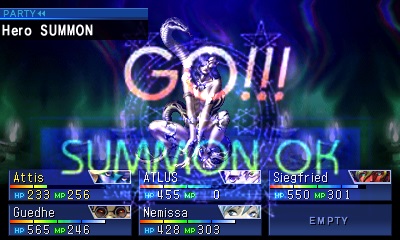 The battle formation is significant in Soul Hackers since some weapons are short range and can only hit an enemy in the front row, and the front row of the player’s party is likely to receive the brunt of the enemy’s attacks. There are also long range weapons that can attack from the back row and a variety of spells and abilities that can hit a whole row of enemies or all enemies. Of course, the enemy demons have access to many of the same skills, and they frequently target the most vulnerable member of the player’s party.
The battle formation is significant in Soul Hackers since some weapons are short range and can only hit an enemy in the front row, and the front row of the player’s party is likely to receive the brunt of the enemy’s attacks. There are also long range weapons that can attack from the back row and a variety of spells and abilities that can hit a whole row of enemies or all enemies. Of course, the enemy demons have access to many of the same skills, and they frequently target the most vulnerable member of the player’s party.
If one of the allied demons is killed, that demon is not only dead, but it is sent back into the computer, so in order to bring it back to the battlefield, it must first be revived, and then summoned, a process that takes two turns. Fortunately, the computer stores 12 demons (after an upgrade), so if one demon is incapacitated, the player can always summon another demon instead of taking the time to revive the fallen one.
If the protagonist is killed, it’s Game Over (and a boot to the Title screen), and death can come suddenly from a variety of sources. One hit kills like the Mudo line of death spells and the Hama line of exorcism spells are not uncommon, and petrifying abilities are just as deadly as the player is never given an opportunity to cure that status ailment before arriving on the Game Over screen if the protagonist is afflicted. Enemies eventually start using versions of these skills that can target the entire party, and there are moments where it feels like the odds are really stacked against you. Given the scarcity of save points in the dungeons, it is not unusual to have to replay large sections of the game over and over again until you make some progress and are able to save again.
Fortunately, Soul Hackers provides the opportunity for the player to install special software into their computer which allows the game to be saved anywhere. Though the computer only has 5 slots for software and the “Back-Upper” program uses 2 slots, I kept that software in my computer throughout the majority of the game, and saved every few minutes in the more difficult dungeons, which alleviated the frustration I was starting to feel from losing progress. Other available software includes programs that prevent back attacks or increase the likelihood of surprising the enemy, cosmetic modifications that change how the party panel looks in combat and informative software such as a clock or a display that shows the enemy encounter rate. There is also software to aid in Demon Fusion (more on that later) and negotiations with demons should the player choose to converse with them instead of trying to defeat them.
We Need to Talk
 Although they can be defeated for experience and other resources, talking to demons is often preferable to fighting them. When a conversation starts, the demon will usually ask some sort of question. If the player provides the right answers (from multiple choices) according to the demon’s personality, a number of things could happen. The player might be given money, Magnetite (MAG, the resource used to summon demons into the player’s active party and to sustain them), items or healing. An opportunity to escape might present itself, or the demon could flee on its own. The demon might also ask for a gift, so the player can give it money, MAG or an item. Of course, these are demons, so many of them will take the gift and run away with it, or demand even greater compensation. If negotiations go poorly, the demon might attack immediately or walk away in disgust.
Although they can be defeated for experience and other resources, talking to demons is often preferable to fighting them. When a conversation starts, the demon will usually ask some sort of question. If the player provides the right answers (from multiple choices) according to the demon’s personality, a number of things could happen. The player might be given money, Magnetite (MAG, the resource used to summon demons into the player’s active party and to sustain them), items or healing. An opportunity to escape might present itself, or the demon could flee on its own. The demon might also ask for a gift, so the player can give it money, MAG or an item. Of course, these are demons, so many of them will take the gift and run away with it, or demand even greater compensation. If negotiations go poorly, the demon might attack immediately or walk away in disgust.
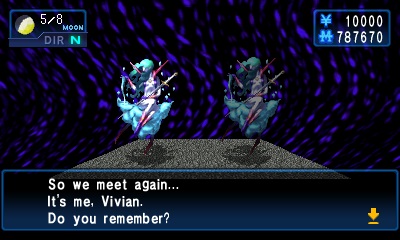 I missed being able to talk to demons in Persona 3 and Persona 4, and I enjoyed conversing with demons a great deal in Soul Hackers, despite a couple of bugs like text appearing beyond the boundaries of the text box and a rare situation in which a Japanese character was somehow never translated into English. Many of the conversations were interesting, and it was fun trying to figure out which answers were appropriate for which demons and their unique personalities. Many of the same questions and answers appeared throughout the game, and after a while I actually got better at negotiating. At first it seemed completely random, but I started to recognize the quirks and dispositions of the demons as I talked to them more and more. Not only that, but these conversations provided the greatest source of humor throughout the entire game. I especially enjoyed trying to convince a completely incoherent demon to join me by responding with equally incoherent nonsense.
I missed being able to talk to demons in Persona 3 and Persona 4, and I enjoyed conversing with demons a great deal in Soul Hackers, despite a couple of bugs like text appearing beyond the boundaries of the text box and a rare situation in which a Japanese character was somehow never translated into English. Many of the conversations were interesting, and it was fun trying to figure out which answers were appropriate for which demons and their unique personalities. Many of the same questions and answers appeared throughout the game, and after a while I actually got better at negotiating. At first it seemed completely random, but I started to recognize the quirks and dispositions of the demons as I talked to them more and more. Not only that, but these conversations provided the greatest source of humor throughout the entire game. I especially enjoyed trying to convince a completely incoherent demon to join me by responding with equally incoherent nonsense.
The ultimate goal of all of this chatting is usually to get the demon to join the player, assuming there is space for it in the computer. This is often more difficult than it sounds, because demons come in a variety of alignments and may refuse to join if the player already has a demon of the opposite alignment in the computer. The protagonist must also be high enough in level to be able to control the demon before it will join, and must be able to communicate in the demon’s language. Unknown languages can be added to the computer as software.
Raising Demons
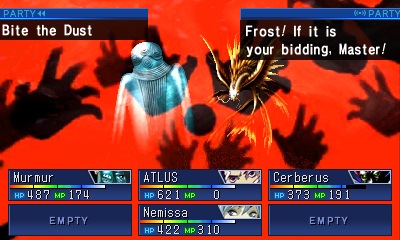 Once on the team, the demon may or may not obey the player’s commands in combat according to its level of loyalty. Just because a demon is on your team doesn’t mean it trusts you! Demons also refuse to be summoned into the active party if the player has already summoned a demon of the opposite alignment (though this can be overcome by enabling an optional alignment hack). To increase loyalty, the player must command the demon to use the spell or ability that it would have decided to use on its own in any given situation. At first this seems like a complete mystery, but with enough information, it’s not difficult to choose the right skill. Each demon has a personality type that determines the kinds of abilities it likes to use. Sly demons love to use attack spells, Kind demons enjoy healing, and Wild demons prefer aggressive abilities and basic attacks. Also, ordering the demon to “Go” and make its own choice is an easy way to figure out what ability it would use against a certain opponent (and is usually the correct choice to improve the loyalty of Calm and Dumb demons). Once a demon’s loyalty is maxed out, it will almost never disobey the player.
Once on the team, the demon may or may not obey the player’s commands in combat according to its level of loyalty. Just because a demon is on your team doesn’t mean it trusts you! Demons also refuse to be summoned into the active party if the player has already summoned a demon of the opposite alignment (though this can be overcome by enabling an optional alignment hack). To increase loyalty, the player must command the demon to use the spell or ability that it would have decided to use on its own in any given situation. At first this seems like a complete mystery, but with enough information, it’s not difficult to choose the right skill. Each demon has a personality type that determines the kinds of abilities it likes to use. Sly demons love to use attack spells, Kind demons enjoy healing, and Wild demons prefer aggressive abilities and basic attacks. Also, ordering the demon to “Go” and make its own choice is an easy way to figure out what ability it would use against a certain opponent (and is usually the correct choice to improve the loyalty of Calm and Dumb demons). Once a demon’s loyalty is maxed out, it will almost never disobey the player.
Unlike in Persona 3 and Persona 4, the demons in Soul Hackers do not level up, so the only way to get stronger demons is via new recruits from random encounters or by using Demon Fusion to combine two or three demons into a new one. Fortunately, Soul Hackers includes the “Fusion Search” feature from recent Shin Megami Tensei games, so it is easy to determine which demons can be fused using the demons currently in your computer instead of manually testing every combination. There are around 275 demons in Soul Hackers, and any previously controlled demon can be summoned from the Demon Compendium for a large amount of MAG.
Magnetite is actually a fairly limited resource early in the game because demons not only cost MAG to recover from the compendium and summon from the computer into the active party, but they also consume a certain amount of MAG for every step the player takes in a dungeon. Normally this cost is offset by the rewards after battle, but it is quite easy for the player to summon a variety of demons that consume far more mag during the steps taken between random encounters than those encounters actually provide. If the player runs out of MAG completely, the summoned demons will lose health with every step and eventually die. It is actually a very interesting gameplay mechanic, as it forces the player to choose his or her active demons very carefully or to even travel with a smaller party.
 Once the player completes a certain quest, however, a demon called a Zoma can be fused. This unique demon is usually a bit weaker than the demons used to fuse it, but it can inherit nearly every skill from those demons, and it is free to summon and maintain. Between the protagonist, Nemissa and the Zoma, there is enough fire power to get through the random encounters, so that is one way to overcome a MAG deficit.
Once the player completes a certain quest, however, a demon called a Zoma can be fused. This unique demon is usually a bit weaker than the demons used to fuse it, but it can inherit nearly every skill from those demons, and it is free to summon and maintain. Between the protagonist, Nemissa and the Zoma, there is enough fire power to get through the random encounters, so that is one way to overcome a MAG deficit.
Other special fusions are also available, such as combining a regular demon with an Element to change that demon into a more powerful demon of the same race (such as turning a Fairy Pixie into a Fairy Penanggal or a Fairy Penanggal into a Fairy Jack Frost). A demon can also be fused with a Mitama to raise its stats. To get an Element, two demons of the same race must be combined, and to get a Mitama, two Elements have to be fused. The depth of the fusion system is really quite impressive. There are rules that govern what new skills the demons inherit from their parent demons and how to obtain demons of specific races. Even the various phases of the moon have an impact on what races can and cannot be fused (and also affect the power of demons during combat and their attitudes during conversations). Demons can also be turned into weapons through a process called Sword Fusion or, if their loyalty is maxed, into special items via Mystic Change.
A Difficult Journey With Little Guidance
If this all sounds overwhelming, it can be. Especially considering how many secrets are hidden in odd places. For example, many of the details about advanced Demon Fusion are only revealed after the player delivers certain demons to a pet shop in the virtual reality city, Paradigm X. Other details might be exposed during conversations with particularly informed demons. In general, Soul Hackers does very little handholding. There is no tutorial for combat and there is no way to see descriptions of what the various skills in the game do unless you have a demon with the ability you want to know about and are selecting from its skills during a fight. Enemy abilities can be a complete mystery, and figuring out which skills are useful when viewing demon analysis outside of combat or while fusing demons can be frustrating. It doesn’t help that the names of the abilities rarely reflect what the abilities do, so to newcomers to Shin Megami Tensei, spells like Bufu, Agi, Zan and Zio could really be anything.
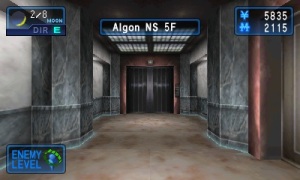 The dungeons themselves can also be challenging to navigate. Beyond their intentionally baffling design filled with tons of elevators, locked doors and switches, they also employ every dirty Shin Megami Tensei trick in the book, including pit traps that drop you to the floor below (but are sometimes actually the correct way to go), one-way doors, teleporters, damage traps, and obscure puzzles. The game also takes every chance it gets to be mean to the player. For example, if a puzzle requires an answer to a question, an incorrect answer will result in the player being teleported back to an earlier point in the dungeon, and the player will have to fight through several random encounters before being able to attempt the puzzle again. One of the optional dungeons is particularly cruel in the regard, as the encounter rate there is higher than anywhere else in the game with a fight occurring around every 1 to 5 steps, and each battle having far more demons than usual (it’s a great place to grind though).
The dungeons themselves can also be challenging to navigate. Beyond their intentionally baffling design filled with tons of elevators, locked doors and switches, they also employ every dirty Shin Megami Tensei trick in the book, including pit traps that drop you to the floor below (but are sometimes actually the correct way to go), one-way doors, teleporters, damage traps, and obscure puzzles. The game also takes every chance it gets to be mean to the player. For example, if a puzzle requires an answer to a question, an incorrect answer will result in the player being teleported back to an earlier point in the dungeon, and the player will have to fight through several random encounters before being able to attempt the puzzle again. One of the optional dungeons is particularly cruel in the regard, as the encounter rate there is higher than anywhere else in the game with a fight occurring around every 1 to 5 steps, and each battle having far more demons than usual (it’s a great place to grind though).
With all that being said, Soul Hackers is probably the wrong game to use to introduce a new player to Shin Megami Tensei. But for series veterans, it provides dozens of hours of demon fusing goodness and plenty of challenging battles. Even beyond the main game, there is a lot of additional post game content to keep players occupied. During the main game, there is a dungeon that unlocks one floor at a time as you progress through the story, and each floor contains the latest enemies that have been encountered prior. After beating the game, the top floor of that dungeon actually becomes a hub for additional mini dungeons, and another post-game dungeon (also with multiple branches) can be played by selected Extra Game on the title screen. And of course, there is the matter of completing 100% of the Demon Compendium, which is no small task given the depth of the fusion system. When I finished the game around the 40 hour mark, I had only completed 60% of the Demon Compendium (and a small fraction of the Sword Compendium which lists the various weapons created through Sword Fusion).
Soul Hackers also has a few optional mini-games. Within Paradigm X there is a casino that includes two types of poker, two slot machines and a dice throwing game that plays like a basic version of Craps. The coins earned in the casino can be traded for a variety of items, including a couple of the most powerful weapons in the game. There are also a range of distractions, like fortune telling for your love life and a quiz game that asks you tons of questions unrelated to anything in Soul Hackers. Then there is the previously mentioned Pet Shop, which challenges you to bring in rare demons, or demons with specific abilities or other qualities in exchange for useful prizes or information. Far less useful is the Bank, which during my game provided interest on my deposits that was as insulting as my real life savings account. Finally, there is a fortune teller who will provide free advice for players that have forgotten what to do next, though the game does a good job of reminding the player about the current objectives anyway.
Welcome Shin Megami Tensei Veterans
There is a lot to do in Shin Megami Tensei: Devil Summoner: Soul Hackers, though it is short compared to Persona 3 or Persona 4. There is a hack available that makes the game easier or harder, so an additional playthrough with the hard mode hack enabled might provide additional replay value to some players. There’s also a New Game+ mode that can be accessed only after beating all of the post-game optional bosses. Ultimately, whether or not you will enjoy the game depends on what you enjoy about RPGs. If you’re in it mainly for the story, despite some excellent voice talent, Soul Hackers falls a bit short, and opponents of random encounters beware. But for the player that enjoys getting lost in dungeons full of puzzles, fighting through countless encounters and collecting demons, Soul Hackers is just what the doctor ordered. It is classic and traditional Shin Megami Tensei, and it will certainly keep you busy until Shin Megami Tensei IV launches this summer (also on the 3DS).
Ari played a total of 50 hours of Soul Hackers, and completed the main quest in 40 on the default difficulty setting. Atlus provided a copy of the game for review purposes.
Related Link(s):
 + Large List of Demons to Fuse and Collect
+ Large List of Demons to Fuse and Collect
+ Talented and Entertaining Voice Acting
+ Demon Conversations
+ Managing Demon Loyalty and Party Alignment
-Pacing Between Story Elements and Dungeon Crawling
-No Spell or Ability Descriptions Outside of Combat
-Low Resolution Movies
Available on: 3DS
Version Reviewed: 3DS

It was a fair review, glad to see a review that doesnt compare these games with Persona, maybe a Strange Journey comparison would had been more adequate instead of SMT 3 and DDS as SJ is more old school. I think i will like this game a lot thanks to Strange Journey, that comparison would had yield better results.
In all it was a long and cohesive review, thumps up.
LikeLike